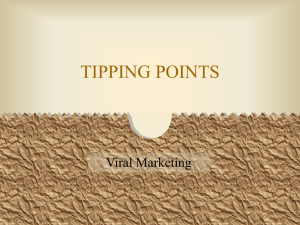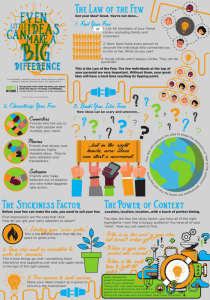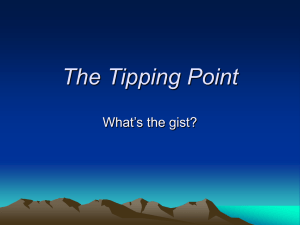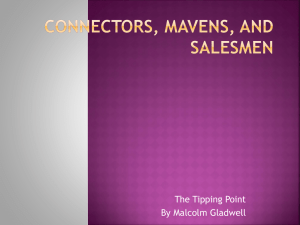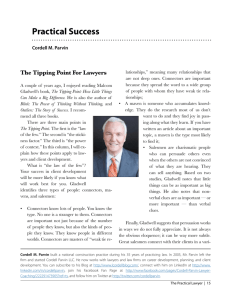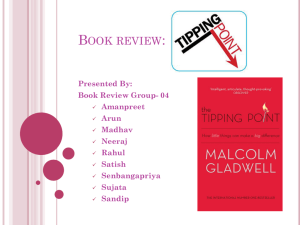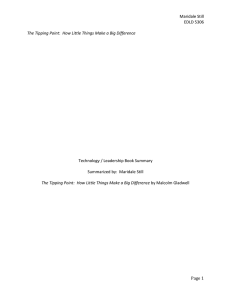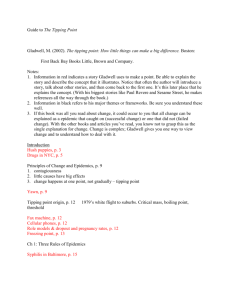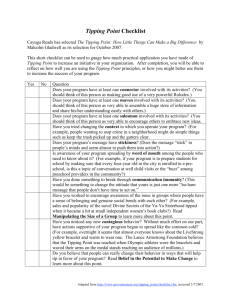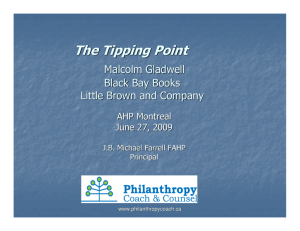Tipping Points 2
advertisement
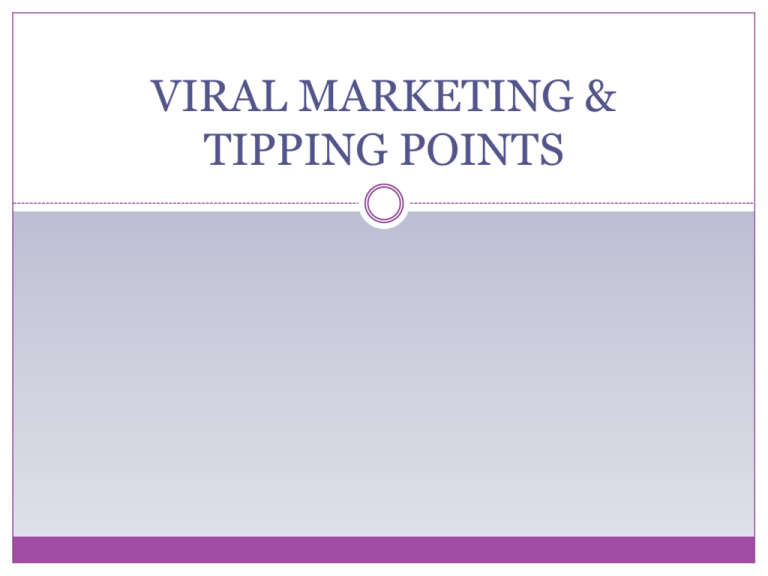
VIRAL MARKETING & TIPPING POINTS Malcolm Gladwell’s best seller Thomas Schelling (Nobel Prize winner) first introduced the concept of “tipping points” in 1972 Malcolm Gladwell popularized the concept in his best seller Downside of traditional marketing Cost: TV and print ads are expensive Media clutter: It is difficult for products to stand out against the background of advertising Cynicism: Consumers, especially Gen X and Gen Y consumers, are jaded and cynical about “obvious” marketing TIVO, DVRs: Consumers can avoid TV commercials altogether Segmentation: Consumers aren’t heterogeneous, they are segmented into different markets Viral Marketing Steve Jurvetson and Tim Draper coined the term “viral marketing” in 1997. a.k.a. below the radar marketing, buzz marketing, stealth advertising Companies now devote roughly 15 percent of their marketing budgets to buzz and related strategies (Martin & Smith, 2008) Relies on word-of-mouth (WOM) endorsements like a virus, word about a product or service spreads from one consumer to another “67 percent of sales of U.S. consumer goods are now influenced by word of mouth” (Salzman, Matathia, & O’Reilly, 2003, p. 31). Conduits for viral marketing Face-to-face interaction Twitter Cell phone Social networking media Email MySpace Facebook Blogs Texting Instant messaging Examples, intentional and unintentional Twitter, tweeting Live Strong bracelets (and the whole wrist band craze) Ipods, Iphones accessory dogs “Support Our Troops” stickers Hip Hop (culture as a commodity) More examples of buzz Flash mobs MySpace, Facebook YouTube Blogs, blogging, the blogosphere Pinkberry Razor scooters Harry Potter books Wii Fit Methods and techniques Poseurs: “ordinary person at a bar, in line at a concert, at a soccer field Sony Ericcson hired 120 actors and actresses to play tourists at popular attractions around the country.The “tourists” asked passersby to take their picture with a T68i cell phone that featured a digital camera Trendsetters and early adopters Use of “cool hunters” and “trend spotters” Imitation, social modeling yellow magnetic ribbons saying “Support the Troops” Email, chat rooms, and blogs Manufactured controversies: Ambercrombie & Fitch sold thong underwear in children’s sizes, with the words “eye candy” printed on the front Malcolm Gladwell’s notion of “Tipping Points” Tipping point: the threshold or critical point at which an idea, product, or message takes off or reaches critical mass. Viral theory of marketing: ideas and messages can be contagious just like diseases The law of the few It doesn’t take large numbers of people to generate a trend A select few enjoy a disproportionate amount of influence over the spread of social trends Key influencers: Mavens Mavens: possess information, expertise, and seek to share it “Mavens are data banks. They provide the message” (Gladwell) Are “in the know” Alpha consumers or early adopters (keller & Berry, 2003) Examples: celebrity chefs, eco-enthusiasts, fashion aficionados, fitness gurus, tech geeks, wine snobs “One American in 10 tells the other nine how to live” (Keller & Barry, 2003) Mavens may be somewhat socially awkward or “geeky” Mavens want to educate more than persuade or sell. Key Influencers: Connectors Connectors: know everybody, are networkers, have many contacts “Connectors are social glue: they spread it.” (Gladwell) Have large social circles They are social gadflies; they blog, chat, text, twitter They are the people who always forward emails to you. 6 degrees of separation: a small number of people, like Kevin Bacon, are linked to everyone else Key Influencers: Salesman Salesman: are persuasive Charismatic types Good at building rapport, trust Often rely on “soft” influence They are the friends who tell us: “you gotta see this movie,” “check out this YouTube video” “You have got to try this restaurant.” Note: All three types are needed for a phenomenon to take-off Tipping points--continued Power of context must happen at the right time, place for example, social networking (MySpace, Facebook) wouldn’t be possible without widespread access to the Internet The stickiness factor idea, message, or product has to be “sticky” or inherently attractive idea must be memorable, practical, personal, novel hard to manufacture this feature Other concerns Scalability: message must be able to go from very small to very large without “gearing up.” Wii couldn’t ramp up manufacturing and lost millions in sales. Effortless transfer: message must be passed on for free, or nearly free, or “coast” on existing networks. “word of mouse” Leveraging free media The downside Not that scientific Momentum may not reach the tipping point evidence is largely anecdotal no guarantee the initial phenomenon isn’t that “buzz” will become reliable, predictable contagious. A bit of a “finger in the difficult to orchestrate word wind” approach to of mouth marketing good ideas don’t always gain viral marketing” is traction something of an Trends come and go oxymoron. quickly The more viral marketing is planned or contrived, the like a contagion, a trend can less likely it is to succeed die out quickly or be replaced by a new trend Viral marketing may backfire: Wal-mart and Facebook
